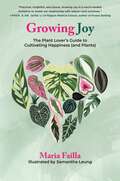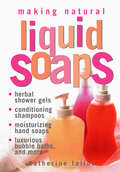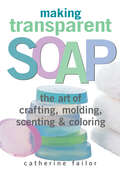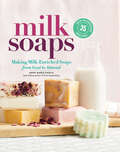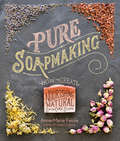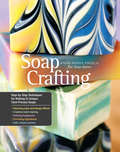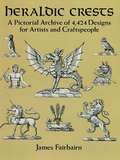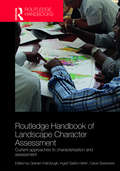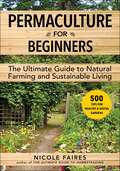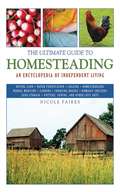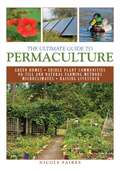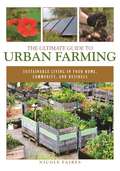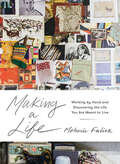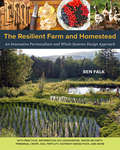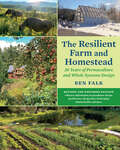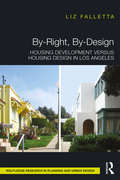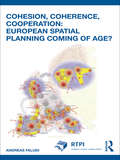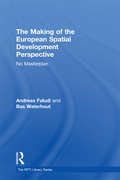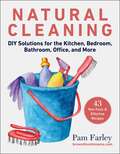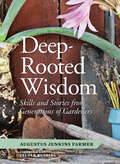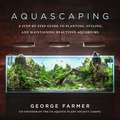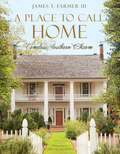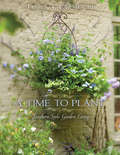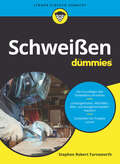- Table View
- List View
Growing Joy: The Plant Lover's Guide to Cultivating Happiness (and Plants)
by Maria FaillaPlanty practices to grow your way to happier, more peaceful lifeDiscover the power of plants to help you disconnect from the stress and anxiety of modern life and grow more joy in your world. Filled with practices to help plant lovers step away from their screens and cultivate delight and peace of mind with plants, Growing Joy is your guide to transforming plant care into self-care. In easy to read, light-hearted chapters, author Maria Failla, host of the beloved podcast Bloom and Grow Radio, explores the science behind our love of plants and shares how that humble aloe plant on your windowsill can unlock a world of wellness and delight. With ideas and tips both big and small—from simply making a habit of looking at a plant before looking at a screen in the morning to creating a plant-infused restorative retreat in your home—Growing Joy will help you create a meaningful wellness practice rooted in nature and connection. And of course, there’s some plant care tips in there too to make sure both you and your green friends thrive! Whether you’re a plant parent pro or the anxious owner of a single, not-dead-yet succulent, Growing Joy will help you reconnect with yourself, bring more smiles to your face and peace in your heart, and inspire a lifelong relationship with plants that will keep you blooming and growing.
Making Natural Liquid Soaps: Herbal Shower Gels, Conditioning Shampoos, Moisturizing Hand Soaps, Luxurious Bubble Baths, and more
by Catherine FailorMake our own liquid soaps and body products right in your kitchen. Catherine Failor shows you how to use her simple double-boiler technique to create luxurious shower gels, revitalizing shampoos, energizing body scrubs, and much more. Step-by-step instructions teach you how to turn basic ingredients like cocoa butter, lanolin, and jojoba into sweet-smelling liquid soaps. You’ll soon be experimenting with your favorite oils and additives as you craft custom-made products that are kind to your nose and gentle on your skin.
Making Transparent Soap: The Art Of Crafting, Molding, Scenting & Coloring
by Catherine FailorWith basic ingredients and standard kitchen tools you can craft your own transparent soaps that are milder, richer, and creamier than any commercial product. Eschewing complex methods and expensive equipment, Catherine Failor uses a simple, dependable process that makes beautiful transparent soaps every time. Failor’s easy-to-follow photographic instructions are accompanied by proven recipes and plenty of suggestions for colorful and sweet-smelling variations. You’ll soon be creating your own signature soap blends that deliver refreshing scents and are gentle enough for even the most sensitive skin.
Milk Soaps: 35 Skin-Nourishing Recipes for Making Milk-Enriched Soaps, from Goat to Almond
by Anne-Marie FaiolaHandmade soap is made extra-special with the addition of milk! Soaps enriched with milk are creamier than those made with water, and milk’s natural oils provide skin-renewing moisture and nourishment. In Milk Soaps, expert soapmaker Anne-Marie Faiola demystifies the process with step-by-step techniques and 35 recipes for making soaps that are both beautiful and useful. She explains the keys to success in using a wide range of milk types, including cow, goat, and even camel milk, along with nut and grain milks such as almond, coconut, hemp, rice, and more. Photographs show soapmakers of all levels how to achieve a variety of distinctive color and shape effects, including funnels, swirls, layers, and insets. For beginners and experts alike, this focused guide to making milk-enriched soaps offers an opportunity to expand their soapmaking skills in new and exciting ways. This publication conforms to the EPUB Accessibility specification at WCAG 2.0 Level AA.
Pure Soapmaking: How to Create Nourishing, Natural Skin Care Soaps
by Anne-Marie FaiolaThe pure luxury of soaps made with coconut butter, almond oil, aloe vera, oatmeal, and green tea is one of life&’s little pleasures. And with the help of Anne-Marie Faiola, author of Soap Crafting and Milk Soaps, it&’s easy to make luscious, all-natural soaps right in your own kitchen. This collection of 32 recipes ranges from simple castile bars to intricate swirls, embeds, and marbled and layered looks. Begin with a combination of skin-nourishing oils and then add blueberry puree, dandelion-infused water, almond milk, coffee grounds, mango and avocado butters, black tea, or other delicious ingredients — and then scent your soap with pure essential oils. Step-by-step photography guides you through every stage of cold-process soapmaking.
Soap Crafting: Step-by-Step Techniques for Making 31 Unique Cold-Process Soaps
by Anne-Marie FaiolaMake your own custom-tailored and perfectly formed cold-process soaps! Learn how to use milk jugs and yogurt containers for molds, and how coffee, avocado, and even beer can add unique dimensions to your creations. This encouraging introduction to the art of soapmaking makes it simple to master the techniques you need to safely and easily produce your own enticingly fragrant soaps.
Heraldic Crests: A Pictorial Archive of 4,424 Designs for Artists and Craftspeople (Dover Pictorial Archive)
by James FairbairnRich selection of royalty-free motifs from famous British reference. Striking, varied designs suitable for any number of graphic projects. Images include lions, tigers, wreaths, falcons, rosettes, human figures, mythical creatures, crowns, and much more. Add aristocratic flair to book and magazine illustrations, advertisements, newsletters, etc.
Routledge Handbook of Landscape Character Assessment: Current Approaches to Characterisation and Assessment
by Graham Fairclough Ingrid Sarlöv Herlin Carys SwanwickIn this multi-authored book, senior practitioners and researchers offer an international overview of landscape character approaches for those working in research, policy and practice relating to landscape. Over the last three decades, European practice in landscape has moved from a narrow, if relatively straightforward, focus on natural beauty or scenery to a much broader concept of landscape character constructed through human perception, and transcending any of its individual elements. Methods, tools and techniques have been developed to give practical meaning to this idea of landscape character. The two main methods, Landscape Character Assessment (LCA) and Historic Landscape Characterisation (HLC) were applied first in the United Kingdom, but other methods are in use elsewhere in Europe, and beyond, to achieve similar ends. This book explores why different approaches exist, the extent to which disciplinary or cultural specificities in different countries affect approaches to land management and landscape planning, and highlights areas for reciprocal learning and knowledge transfer. Contributors to the book focus on examples of European countries – such as Sweden, Turkey and Portugal – that have adopted and extended UK-style landscape characterisation, but also on countries with their own distinctive approaches that have developed from different conceptual roots, as in Germany, France and the Netherlands. The collection is completed by chapters looking at landscape approaches based on non-European concepts of landscape in North America, Australia and New Zealand. This book has an introductory price of £125/$205 which will last until 3 months after publication - after this time it will revert to £140/$225.
Permaculture for Beginners: The Ultimate Guide to Natural Farming and Sustainable Living
by Nicole FairesTake your garden to the next level—organic, native, and natural! Permaculture is an important but often misunderstood method of growing food and building homes in a manner that works with nature, rather than against it, to create beautiful, healthy, and useful gardens. Blending ecology, organic agriculture, green home design, appropriate technology, and biology can be confusing and overwhelming, but Permaculture for Beginners simplifies this vast field for practical application. This is a hands-on guide, taking the beginner through each step of the design process, so that anyone can apply permaculture principles to their own life. While the principles are simple, the in-depth topics cover every aspect of permaculture, including: Building green homes and passive solar design Growing edible plant communities and forest gardens Using no-till and natural farming methods Creating microclimates for extended growing seasons Raising livestock with ecological foraging techniques Transforming urban backyards into food-abundant oasesThis is a commonsense approach to sustainable living that creates a self-sufficient and low-effort home for the people that live there, whether in the city or the country. Permaculture for Beginners isn&’t a philosophy book, or a dissertation on theory. It is a step-by-step, complete guide to every aspect of permaculture.
The Ultimate Guide to Homesteading: An Encyclopedia of Independent Living (The Ultimate Guides)
by Nicole FairesCan you make your own bread (sans bread machine)? Grow a garden all winter? What can you use instead of toilet paper? What if the power went out for a month? What if the grocery store closed? Can you make a solar oven? Store food without electricity? Raise a water buffalo? Make fine linen from stinging nettle? Make your own shampoo? Deliver a baby? Is it possible to be totally self-sufficient? This massive, full-color book answers all these questions and thousands more and includes checklists, diagrams, and instructions on how to buy a sheep. All of the information included meets these criteria: It is something that anyone can do, without special training. It can be done with relatively few supplies or with stuff you can make yourself. It has been tried and tested--either by the author, the military, doctors, or other homesteaders. The Ultimate Guide to Homesteading is not a storybook or a cookbook. It is a practical guide with nitty-gritty details on everything a homesteader can do, step-by-step with hundreds of color illustrations and pen and ink sketches. You can do it! This book can help.
The Ultimate Guide to Permaculture: Permaculture For Beginners (Ultimate Guides)
by Nicole FairesPermaculture is an important but often misunderstood method of growing food and building homes in a manner that works with nature, rather than against it, to create beautiful, healthy, and useful gardens. Blending ecology, organic agriculture, green home design, appropriate technology, and biology can be confusing and overwhelming, but The Ultimate Guide to Permaculture simplifies this vast field for practical application. This is a hands-on guide, taking the beginner through each step of the design process, so that anyone can apply permaculture principles to their own life. While the principles are simple, the in-depth topics cover every aspect of permaculture, including:- Building green homes and passive solar design - Growing edible plant communities and forest gardens - Using no-till and natural farming methods - Creating microclimates for extended growing seasons - Raising livestock with ecological foraging techniques This is a common-sense approach to sustainable living that creates a self-sufficient and low-effort home for the people that live there, whether in the city or the country. The Ultimate Guide to Permaculture isn't a philosophy book, or a dissertation on theory. It is a step-by-step, complete guide to every aspect of permaculture.
The Ultimate Guide to Urban Farming: Sustainable Living in Your Home, Community, and Business
by Nicole FairesHow to maximize your food production in an urban environment.The idea of bringing agriculture into the city has been promoted by many on both sides of the political fence: proponents of sustainability and prevention of climate change as well as those who worry about government and social instability. To address the urgent need for a shift in the way our food is produced, The Ultimate Guide to Urban Farming offers a practical education in everything there is to know about city agriculture: how to grow a lot of food in any kind of urban living situation, from apartment to full-scale commercial venture.Subjects covered include: Small scale vs. large scale agriculture The economic, social, health, and environmental impacts of urban farming Making the most of the space available The latest technologies and developments in agriculture, including: hydroponics, vertical gardening, and aquaponics Case studies and design concerns for community-based farming The best plant species for cities and seasons Beekeeping and small animals Commercial agriculture and the business side of farming in a city environmentThis comprehensive guide will introduce readers to the rewarding possibilities of growing their own food, as well as dispel the falsehood that says we need faraway factory farms to produce everything we eat.
Making a Life: Working by Hand and Discovering the Life You Are Meant to Live
by Melanie Falick&“Falick&’s treasury, sumptuously photographed, will appeal to anyone who admires the people dedicated to making the world around them more beautiful.&” —Publishers Weekly, starred reviewWhy do we make things by hand? And why do we make them beautiful? Led by the question of why working with our hands remains vital and valuable in the modern world, author and maker Melanie Falick went on a transformative, inspiring journey. Traveling across continents, she met quilters and potters, weavers and painters, metalsmiths, printmakers, woodworkers, and more, and uncovered truths that have been speaking to us for millennia yet feel urgently relevant today: We make in order to slow down. To connect with others. To express ideas and emotions, feel competent, create something tangible and long-lasting. And to feed the soul. In revealing stories and gorgeous original photographs, Making a Life captures all the joy of making and the power it has to give our lives authenticity and meaning.
The resilient farm and homestead: an innovative permaculture and whole systems design approach
by Ben Falk"The Resilient Homestead" is a manual for developing durable, beautiful, and highly functional human habitat systems fit to handle an age of rapid transition. Ben Falk is a land designer and site developer whose permaculture-research farm has drawn national attention. The site is a terraced paradise on a hillside in Vermont that would otherwise be overlooked by conventional farmers as unworthy farmland. Falks wide array of fruit trees, rice paddies(relatively unheard of in the Northeast), ducks, nuts, and earth-inspired buildings is a hopeful image for the future of regenerative agriculture and modern homesteading. The book covers nearly every strategy Falk and his team have been testing at the Whole Systems Research Farm over the past decade, as well as experiments from other sites Falk has designed through his off-farm consulting business. The book includes detailed information on earthworks; gravity-fed water systems; species composition; the site-design process; site management; fuelwood hedge production and processing; human health and nutrient-dense production strategies; rapid topsoil formation and remineralization; agroforestry/silvopasture/grazing; ecosystem services, especially regarding flood mitigation; fertility management; human labor and social-systems aspects; tools/equipment/appropriate technology; and much more, complete with gorgeous photography and detailed design drawings. "The Resilient Homestead" is more than just a book of tricks and techniques for regenerative site development, but offers actual working results in living within complex farm-ecosystems based on research from the "great thinkers" in permaculture, and presents a viable home-scale model for an intentional food-producing ecosystem in cold climates, and beyond. Inspiring to would-be homesteaders everywhere, but especially for those who find themselves with "unlikely" farming land, Falk is an inspiration in what can be done by imitating natural systems, and making the most of what we have by re-imagining whats possible. A gorgeous case study for the homestead of the future.
The Resilient Farm and Homestead, Revised and Expanded Edition: 20 Years of Permaculture and Whole Systems Design
by Ben Falk“This is one of the most practical, down-to-earth, dirt-under-the-fingernails, comprehensive explanations of all things homesteading and small farming. Whether you’re just dreaming or an old hand, Ben Falk’s longer experience horizon is invaluable.”—Joel Salatin, cofounder, Polyface Farm; author of Everything I Want to Do Is Illegal Informed by twenty years of successful land management and the professional design experience of his pioneering firm Whole Systems Design, LLC, author Ben Falk updates his classic text and delivers the definitive twenty-first century systems thinking manual in self-reliance—sure to empower readers to prioritize projects, make positive lifestyle decisions, and take strategic steps toward a regenerative future. In The Resilient Farm and Homestead, Revised and Expanded Edition Falk describes how he has transformed a degraded hillside in the frigid Vermont climate into a thriving, biodiverse Eden that now provides year-round abundance for his family and community. First published in 2013, The Resilient Farm and Homestead is a comprehensive how-to guide for building durable and productive land-based systems through the reciprocal interplay of humans and the natural world. In the ten years since he first published this seminal work, Falk has deepened his wisdom in harnessing nature-based solutions for increasingly challenging times, including addressing severe climate disruptions like drought and flood conditions. The book covers every strategy Falk and his team have tested on the Whole Systems Research Farms over the past two decades and includes detailed information on earthworks, gravity-fed water systems, soil fertility management, growing nutrient-dense food and medicine, fuelwood production, agroforestry, managed grazing, and much more. Complete with full-color photography and detailed design drawings, The Resilient Farm and Homestead, Revised and Expanded Edition includes new information on: Designing greenhouses and microclimates Reinvigorating human health and embodying a vigorous lifestyle Raising children on a homestead Creating failure-proof and resilient energy systems Focusing on permaculture beekeeping Cultivating proven cold climate plants Overcoming analysis paralysis and mastering the art of knowing where to start and when to take strategic risks And much, much more! In an age that feels defined by disconnection, disease, and decline, The Resilient Farm and Homestead, Revised and Expanded Edition offers a roadmap to conquering uncertainty, maximizing efficiency, and creating a bountiful, manageable landscape that will endure. “Essential reading for the serious prepper as well as for everyone interested in creating a more resilient lifestyle.”—Carol Deppe, author of The Resilient Gardener “This intelligent, challenging book, rooted somewhere between back-to-the-land idealism and radical survivalism, sees resilience as both planting and building for the use of future generations, but also as preparing food, water, shelter, and the human body and psyche for the onset of any imaginable extreme emergency. . . . The result is a comprehensive, open-ended, theoretical and practical system for a post-carbon-dependent life.”—Publishers Weekly (starred review of first edition)
By-Right, By-Design: Housing Development versus Housing Design in Los Angeles
by Liz FallettaHousing is an essential, but complex, product, so complex that professionals involved in its production, namely, architects, real estate developers and urban planners, have difficulty agreeing on “good” housing outcomes. Less-than-optimal solutions that have resulted from a too narrow focus on one discipline over others are familiar: high design that is costly to build that makes little contribution to the public realm, highly profitable but seemingly identical “cookie-cutter” dwellings with no sense of place and well-planned neighborhoods full of generically designed, unmarketable product types. Differing roles, languages and criteria for success shape these perspectives, which, in turn, influence attitudes about housing regulation. Real estate developers, for example, prefer projects that can be built “as-of-right” or “by-right,” meaning that they can be approved quickly because they meet all current planning, zoning and building code requirements. Design-focused projects, heretofore “by-design,” by contrast, often require time to challenge existing regulatory codes, pursuing discretionary modifications meant to maximize design innovation and development potential. Meanwhile, urban planners work to establish and mediate the threshold between by-right and by-design processes by setting housing standards and determining appropriate housing policy. But just what is the right line between “by-right” and “by-design”? By-Right, By-Design provides a historical perspective, conceptual frameworks and practical strategies that cross and connect the diverse professions involved in housing production. The heart of the book is a set of six cross-disciplinary comparative case studies, each examining a significant Los Angeles housing design precedent approved by-variance and its associated development type approved as of right. Each comparison tells a different story about the often-hidden relationships among the three primary disciplines shaping the built environment, some of which uphold, and others of which transgress, conventional disciplinary stereotypes.
Cohesion, Coherence, Cooperation: European Spatial Planning Coming Of Age? (RTPI Library Series)
by Andreas FaludiSince its foundation the European Union has gradually developed policies that are aimed at achieving increased economic and social cohesion. This book examines the most recent of these, the concept of territorial cohesion. Territorial cohesion is the pursuit of balanced development, competitiveness, sustainable development, and good governance. These concerns are most readily addressed by the formulation of spatial strategies under the umbrella of spatial planning, that brings together a multitude of public and private actors in a process that requires cohesion, coherence and co-operation. This book traces the development of spatial planning at European level and argues that spatial planning can become a vehicle, not only for territorial cohesion, but for EU policy generally.
The Making of the European Spatial Development Perspective: No Masterplan (RTPI Library Series)
by Andreas Faludi Bas WaterhoutThe European Spatial Development Perspective (ESDP) is published in eleven official EU languages and so is the most international planning policy document that exists. This book is the only comprehensive account of the process of preparing, negotiating and adopting this document. It outlines the differing perspectives of the European member states and shows that the last thing its proponents wanted is a masterplan. The Making of the European Spatial Development Perspective is a unique book offering a snapshot of contemporary European spatial planning.
Natural Cleaning: DIY Solutions for the Kitchen, Bedroom, Bathroom, Office, and More
by Pam FarleyProtect your health, reduce waste, and be a better steward of the Earth by making the switch to natural cleaning products with these 43 easy recipes!A clean house should not come at the expense of your health. Common household cleaners are not kid-friendly or pet-friendly—or lung-friendly, or skin-friendly. Store-bought cleaners that contain bleach and ammonia, drain cleaners, toilet cleaners, and more are the cause of thousands of household emergencies each year. These harsh cleaners and artificial fragrances can irritate your eyes and lungs, and exacerbate allergies and asthma. Not to mention how all these chemicals and packaging materials are affecting the environment. Bottom line, your home—and the planet—are simply safer without them.Most people think natural cleaners either:don&’t workare difficult / annoying to makeinvolve a lot of exotic, expensive ingredients that are too hard to findall of the above! The truth is, you can clean every room in your house—curtains, carpet, toilet, tile grout, whatever—without ever touching another bottle of Clorox. In this book, you&’ll learn why these cleaners work, how to stock your home with a few basic ingredients you can grab as needed—and why you shouldn&’t use some of the DIY cleaning recipes you see online. You&’ll also learn: How to safely and naturally clean every surface in your home, from stainless steel appliances to moldy showersWhich natural cleaning ingredients should never be mixed (and why)How to customize your cleaners with essential oilsWhy you should use distilled water instead of tap waterThere&’s even a recipe for cleaning dog toys! Make the switch to non-toxic DIY cleaning solutions now!
Deep-Rooted Wisdom: Skills and Stories from Generations of Gardeners
by Augustus Jenkins FarmerWe have begun to lose some of the most important skills used by everyday gardeners to create beautiful, productive gardens. With a personality-driven, engaging narrative, Deep Rooted Wisdom teaches accessible, commonsense skills to a new generation of gardeners. Soulful gardener, Augustus Jenkins Farmer, profiles experienced and up-and-coming gardeners who use these skills in their own gardens. Enjoy this chance to get planting, propagation, and fertilizing knowledge handed down directly from the experts in the field.
Aquascaping: A Step-by-Step Guide to Planting, Styling, and Maintaining Beautiful Aquariums
by George FarmerLearn how to create and maintain your own underwater ecosystem. Aquascaping is the art of creating beautiful aquariums with natural materials and live plants. From the brilliance of Takashi Amano and numerous other innovators, aquascapes have become a popular way to enjoy aquariums. In Aquascaping: A Step-by-Step Guide to Planting, Styling, and Maintaining Beautiful Underwater Aquariums, planted aquarium expert George Farmer teaches how to create the perfect aquascape. Included in this book are full-color photographs that will supply readers with: Step-by-step instructions on setting up your tankDifferent styling suggestions that best suit your landscapeHow to pick plants, rocks, driftwood, substrate, and aquatic lifeUnderstanding the chemistry and biology involved in keeping a healthy aquariumMaintenance and upkeepAnd much more Creating an underwater ecosystem is not only a rewarding experience, but can bring much peace and relaxation to your life. So whether you&’re a novice aquarist or seasoned aquascaper, Aquascaping will teach you all the tricks of the trade so that your beautiful aquarium can be enjoyed by family, friends, and, most importantly, yourself.
A Place to Call Home: Timeless Southern Charm
by James T. Farmer IIIThe acclaimed interior designer combines rich tradition with modern sensibilities in this beautifully photographed book of homes across the deep South. James Farmer&’s design firm works with clients across the South who want to turn their houses into homes. Now Farmer takes readers on a guided tour of eleven home projects—from makeovers to remodels and new construction—as he brings together a cultivated mix of high and low, storied and new, collected and found; presenting them all as a thoughtfully exhibited array of taste, style, good architecture, and interior comfort. Woven alongside beautiful photography of interiors and exteriors are personal stories James shares about living in the South, the people in his life, and how he fell in love with home design. A Place to Call Home is a beautiful book to inspire Southern style at home―infusing the new with antique, vintage, and heirloom pieces.
A Time to Plant
by James T. Farmer IIIA vital young voice in the gardening scene teaches a new generation of Southerners to love gardening and to make it a focal point of their lifestyle. James Farmer III teaches respect for the age-old rules of flower and vegetable gardening in the Deep South (e.g., May is the time for pruning), in a fresh voice that resonates love of life and entertaining at home. Also included are delicious recipes for seasonal meals, as well as suggestions for floral arrangements and centerpieces from the garden.
Schweißen für Dummies (Für Dummies)
by Steven Robert FarnsworthSie wollen Schweißen lernen? Sei es als Hobby, beruflich oder im Rahmen einer Ausbildung? Dann ist dieses Buch das richtige für Sie. Stephen Robert Farnsworth hilft Ihnen bei den ersten Schritten, das Schweißen zu erlernen. Er erklärt Ihnen, was Sie zu Lichtbogenhand-, MIG/MAG-, WIG- und Autogenschweißen wissen sollten. Sie erfahren, was Sie bei welchen Metallen beachten sollten und wann sich welches Schweißverfahren anbietet. Ein besonderes Augenmerk legt der Autor auf die Sicherheit, denn die geht schließlich immer vor. So sind Sie mit diesem Buch rundum gut beraten, wenn Sie Schweißen lernen wollen.
The Gardens of Emily Dickinson
by Judith Farr Louise CarterIn this first substantial study of Emily Dickinson's devotion to flowers and gardening, Judith Farr seeks to join both poet and gardener in one creative personality. She casts new light on Dickinson's temperament, her aesthetic sensibility, and her vision of the relationship between art and nature, revealing that the successful gardener's intimate understanding of horticulture helped shape the poet's choice of metaphors for every experience: love and hate, wickedness and virtue, death and immortality. Gardening, Farr demonstrates, was Dickinson's other vocation, more public than the making of poems but analogous and closely related to it. Over a third of Dickinson's poems and nearly half of her letters allude with passionate intensity to her favorite wildflowers, to traditional blooms like the daisy or gentian, and to the exotic gardenias and jasmines of her conservatory. Each flower was assigned specific connotations by the nineteenth century floral dictionaries she knew; thus, Dickinson's association of various flowers with friends, family, and lovers, like the tropes and scenarios presented in her poems, establishes her participation in the literary and painterly culture of her day. A chapter, "Gardening with Emily Dickinson" by Louise Carter, cites family letters and memoirs to conjecture the kinds of flowers contained in the poet's indoor and outdoor gardens. Carter hypothesizes Dickinson's methods of gardening, explaining how one might grow her flowers today. Beautifully illustrated and written with verve, The Gardens of Emily Dickinson will provide pleasure and insight to a wide audience of scholars, admirers of Dickinson's poetry, and garden lovers everywhere.
